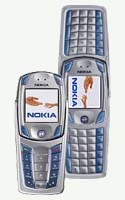GSM review - Nokia 6820 smart phone

 |
Using a Nokia 6820 GSM smart phone - review of GSM in North America ... "smart phones for smart homes" by Adrian Biffen Systems Administrator AeroHOST Web Systems July 21, 2004 |
|
|
Bulletin: RollerTrol™ Automation Systems is Launched!
The original AMPS analog cellphone The North American cellular battlefield has 2 basic competing technologies, TDMA and CDMA. The TDMA system (Time Division Multiple Access) crams more users into the crowded wireless spectrum space by sharing time slices of the same frequency, such as those moments when you're not actually talking (it happens very quickly so you don't really notice). The CDMA approach (Code Division Multiple Access) uses a 'spread spectrum' technology whereby coded/decoded frequency hopping techniques are employed as a method of sharing the airwaves. Arguably, CDMA is a superior technology, but there are other reasons to consider TDMA. GSM (Global Standard for Mobile) technology is actually a type of TDMA, and is used in about 80% of countries worldwide. The US market, up until now, has been dominated largely by CDMA technolgy on the one side vs TDMA PCS technology on the other. If you've ever been to Europe or Mexico and discovered that your phone doesn't work, it's because those countries use primarily GSM technology. GSM also includes the accompanying data service, GPRS (General Packet Radio Service), an 'always on' internet system. I can access and respond to email and web pages directly on the phone, and I can also use the phone as a modem, connected via the wireless Bluetooth system to my laptop for a full display and surfing experience. When I'm out cruising in my sailboat, if I anchor in a cove surrounded by high rocks, I can hoist my phone up to the top of my 50' mast to improve the modem reception, while I sit down in the salon in front of the fireplace, surfing the net - and it works very well! The wonderful Bluetooth technology makes many things possible ... |
||
This article series will cover the reasons behind my decision to choose
GSM / GPRS,  and the subsequent purchase of my Nokia 6820 smartphone. Although
lacking in some features (no kitchen sink or airbags), this little gem
is a modern miracle of technology packed into one very small and
convenient package. It has transformed my daily routine and improved my
life immeasurably.
and the subsequent purchase of my Nokia 6820 smartphone. Although
lacking in some features (no kitchen sink or airbags), this little gem
is a modern miracle of technology packed into one very small and
convenient package. It has transformed my daily routine and improved my
life immeasurably.I would have bought it just for the ability to respond to my email with the full fold-out qwerty keyboard, but it offers much more than that. Another very significant factor is the SIM card (Subscriber Identification Module) - a personal identity card that creates the ability to move from carrier to carrier with an unlocked phone, depending on where you get the best rate and service. Finally, we get a way of having sensible competition between GSM service providers, and no more huge bills from roaming charges. The RF sensitivity of this unit is outstanding, and shows good signal strength in a weak signal area, in a side by side comparison with another phone that doesn't work at all. It is important to hold it at the base and not let the top of the phone (where the antenna is housed) come into contact with anything, but otherwise it will pull in a signal where you couldn't get any before.
I also really like the ability to back up the entire memory contents of
the phone to my laptop, with the provided software. If I ever lose the
phone, or it breaks, I can get another phone and immediately restore the
memory to make it fully functional. That includes contacts, addresses,
phone numbers, configuration, pictures, video ... everything that is in
the phone. |
Home
| What Is x10 | Activehome Pro™ | x10 Software
| Lighting | Appliances
SmartPhones | Home Theatre | Heating |
Water | Security
| Audio/Video | Contact
Copyright ©
2001-2013 Software For Homes